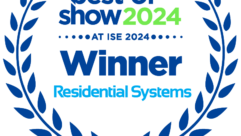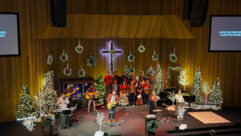
Audio Review: TOA TS-770 Series Conference System
Jun 1, 2008 12:00 PM,
By John McJunkin
Self-explanatory system makes conferencing easy.

TOA Electronics has introduced its TS-770 Series Conference System with the notion of affordably facilitating multiple-mode remote conferencing. In addition to chairperson and delegate mic/speaker units, the system can also accommodate a standard telephone line, a mobile phone, and VoIP or other IP communications using a computer. The system is intended for use in non-permanent applications where a rapid and simple setup process is desirable. And although the system is portable to that extent and easy to set up, it can be expanded to a significant degree with as many as 70 remote units (including multiple chairperson units) on a single TS-770 central unit, via daisy-chaining. Moreover, multiple central units can be employed, facilitating system expansion up to 140 or 210 units — likely exceeding the requirements of most contractors or integrators. Another focus of TOA engineers was to maximize the quality of sound and to bring in the usual accoutrements of such a system, such as chairperson control over the proceedings and archival recording capacity. I test-drove a system consisting of a TS-770 central unit, a TS-771 chairperson unit, a TS-772 delegate unit, a TS-773 microphone, a TS-774 long microphone, and a TS-775 remote delegate interface.
The TS-770 central unit is a rectangular black box with controls and I/O that are simple and straightforward. There are simply three knobs and three switches on the front panel. The three knobs control the line level (that of the various chairperson and delegate units that are connected), the level of a mic connected to the TS-770 front panel, and the level of an auxiliary input also featured on the TS-770 front panel. There is a multiposition switch that limits the number of delegate or chairperson microphones that can be heard simultaneously (zero, one, three, or six). A second switch establishes an automatic microphone timeout of 0, 20, or 40 seconds, which automatically shuts off microphones at the determined interval after the speaker stops speaking. A third switch facilitates the turning on of all connected units. This allows the contractor to establish that all units are successfully connected to the central unit at the time of setup and also to facilitate an open conference in which all mics are intended to stay on permanently. There are also two LED indicators on the front panel — one to indicate the aforementioned “all mic on” mode, and the other to indicate that the unit is receiving AC power.
The rear panel of the TS-770 is also simple and generally self-explanatory. It features a pushbutton power switch and IEC power input along with an expansion switch, which is used to determine whether that particular unit is the main unit or an expansion unit. The TS-770 ships with a plastic binder that must be deliberately removed in order to move the switch from “main” to “expansion.” This is a nice feature to prevent the unintentional jostling of that switch. There are three pairs of RCA jacks facilitating connection to as many as two expansion units — two audio inputs, two audio outputs, and two control connectors as well. The TS-770’s two main inputs from delegate or chairperson units are also featured on the back panel, in an 8-pin DIN format. Recording outputs are found on the rear panel, in the form of a 1/4in. unbalanced jack and a pair of RCA jacks. I presume that the existence of the pair is a courtesy to facilitate recording on both channels of a stereo recording device, despite the fact that the system is monophonic and the signal would be identical on both channels. (Alternatively, two recording devices could be connected.) The final feature of the rear panel is a switchable equalizer I/O loop. A pair of RCA jacks facilitates the export and re-import of the unit’s audio to an equalizer in order to eliminate feedback in a conference room. A switch determines whether the equalizer is inserted.
The TS-771 and TS-772 units (chairperson and delegate, respectively) are also very simple and easy to use. Each has an integrated connection cord; a 4-pin mic connector; a loudspeaker; a mic-in-use LED; a talk key; a volume-control knob; two mini-jack outputs for headphones or recording; a line-connection terminal for daisy-chaining; and a control-output terminal, which provides a control signal linked to the mic-in-use indicator. The chairperson unit also features a priority key — which, when depressed, sounds a chime and effectively locks out all other mics, placing priority on the chairperson.
Audio Review: TOA TS-770 Series Conference System
Jun 1, 2008 12:00 PM,
By John McJunkin
Self-explanatory system makes conferencing easy.
The TS-773 and TS-774 are the two microphones available for the system, and either can be accommodated by either the chairperson or delegate units. Both are cardioid condenser mics with a frequency response of 100Hz to 13kHz. The 100Hz roll-off is a nice mechanism for taming plosives. The TS-773 is 14.5in. in length, and the TS-774 is just short of 20.5in., and having the option for either is nice for contractors who contend with varying table heights. Both have a highly visible red-ring speech-indicator LED below the windscreen.
The TS-775 remote delegate interface unit facilitates the inclusion of external I/O in the form of telephony or IP-oriented communication. Its front panel features a standard modular phone jack, a handset selector switch, mini-jack mic input, mini-jack speaker output, knobs to control input and output levels, a speech-indicator LED, an auto/manual selector switch, and a talk key. The rear panel simply has a line-connection cord, a line-connection terminal for daisy-chaining, and a control output like the chairperson and delegate units. If I may plant a bug in the collective ear of TOA, a USB interface would be nice here to facilitate even easier IP integration.
Considering the uncomplicated and largely self-explanatory nature of the system’s connections and controls, I was able to very easily make connections and get the system up and running in just a few minutes. And it became very clear that the inclusion of more (even many more) delegate or even chairperson units would not complicate matters much at all. The daisy-chain format makes setup incredibly easy. Telephone connection simply required the connection of a standard phone cord to the unit’s modular phone jack. Connection to my laptop computer was also easy, with mini-jack connections both ways. This facilitated VoIP communications, which is rapidly catching on around the business world — particularly with Skype, which is recommended by TOA. Conference operations are simple, with delegates simply pressing their talk buttons to chime in, and granting the chairperson the ability to lock out all other delegates with the priority button. I was pleased with the audio quality of the microphones and the loudspeakers built into the delegate and chairperson units. One of TOA’s goals was to accomplish good-quality audio, and the company has done so indeed. Extension cords to further separate units from each other are available, a welcome fact for contractors.
My bottom-line assessment is that the TS-770 Series Conference System is an affordable, high-quality solution that is exceedingly simple to use. If speed and quality are key requirements, do yourself the favor of taking a look at this system.
John McJunkin is the principal of Avalon Podcasting in Chandler, Ariz. He has consulted in the development of studios and installations, and he provides high-quality podcast-production services.
PRODUCT SUMMARY
- Company: TOA Electronics www.toaelectronics.com
- Product: TS-770 Series Conference System
- Pros: Affordable, simple setup and operation, good quality.
- Cons: No USB interface in the TS-775.
- Applications: Government, corporate, educational, hotel conferencing.
- Price: TS-770: $1,208; TS-771: $494; TS-772: $446; TS-773: $134; TS-774: $208; TS-775: $648
SPECIFICATIONS
TS-770 central unit
- Mic Input: -60dB, 600Ω unbalanced phone jack
- Auxiliary Input: -20dB, 10kΩ unbalanced phone jack
- Recording Output: -20dB, 10kΩ unbalanced phone jack, two RCA jacks
- Equalizer Insertion Terminals: -20dB, 10kΩ RCA jacks, input and output
- Expansion I/O Terminals: -20dB, 10kΩ RCA jacks, input and output
- Control: ≥10kΩ RCA jacks (two)
TS-771 & TS-772 chairperson & delegate units
- Audio Output: 32Ω headphone, -20dB, 10kΩ unbalanced mini-jack
- Contact Output: 24VDC, max 50mA (open collector output)
TS-773 & TS-774 short & long mics
- Type: Electret condenser
- Directivity: Unidirectional
- Rated Impedance: 1.8kΩ
- Rated Sensitivity: -37dB (1kHz, 0dB = 1V/Pa)
TS-775 remote delegate interface
- Input: -60dB, 200Ω balanced mini phone jack
- Output: -60dB, 22Ω balanced mini phone jack









